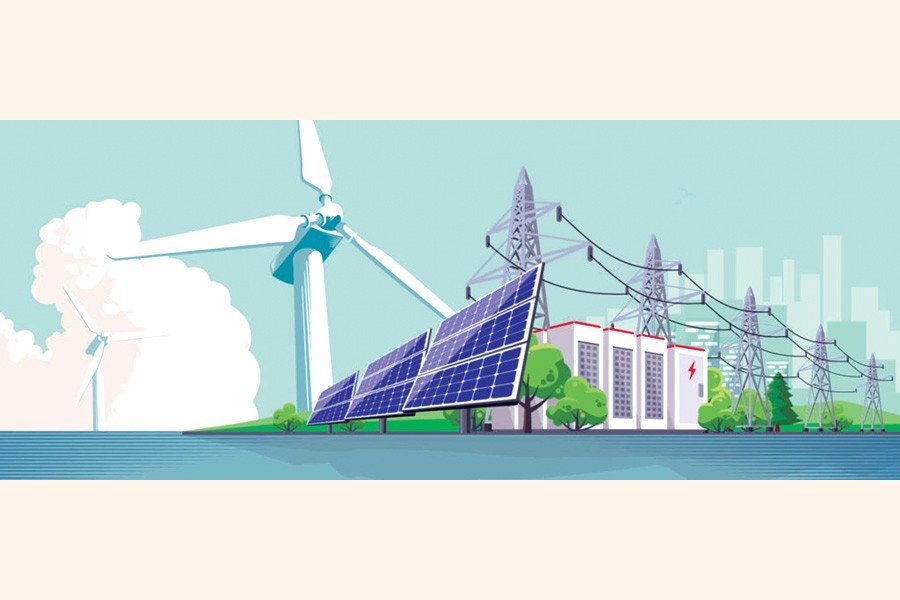The Western civilisation since Industrial Revolution two and a half centuries ago has been thriving on fossil fuel-powered machines. And commercial production of electricity with coal-fired generators began around one and a half centuries ago.
Like spoiled children of Mother Nature, since that time humans have been digging up the fossil fuel reserve tucked away deep in her bowels and burning it with abandon. But it did not take long to find out that the practice is dangerous for life and the environment. But humans need energy to run the machine of growth and development. And burning readily available fossil fuel is the cheapest and easiest way to get energy though it damages the natural environment irreversibly.
Meanwhile major technological breakthroughs have taken place. It is now possible to generate power without burning fossil fuel. The technology to convert sunlight directly into electricity is getting more and more efficient every passing day. The photovoltaic cells are the example of such an efficient technology. Solar panels do exactly that.
Climate change caused by human action, especially fossil fuel burning, has by now reached the tipping point. In response, most advanced nations have been reducing their dependence on fossil fuel-based power production. The oil-guzzling automobiles are also switching to battery-run engines. In short, the technology has come of age to help human society to wean away from fossil energy-based technology. But the pace of changing the energy base of technology from fossil fuel to renewable sources like solar energy is rather slow. The entrenched commercial interests are coming in the way of effecting a faster transition from the fossil to the renewable energy base. Politics serving the interests of the big fossil fuel companies are even trying to downplay the seriousness of the problem of global warming and the climate change that it has triggered.
Oddly enough, they have their followers even in the scientific community. These people try to produce counter arguments against the obvious just to serve certain vested quarters who cannot see beyond their narrow business interests even if those pose a grave threat to the very existence of life on earth, let alone that of humans.
In this context, Bangladesh is in a precariously balanced state. Its vulnerabilities to climate change have increased due to a number of factors. Those include, among others, its close proximity to the sea, its dwindling forest cover, expansion of agricultural lands and human settlements at the expense of forest lands. Roads, industries and growing urban centres are eating up all vacant and fallow lands. With some 1,265 people now living in a square kilometre area, it makes urgent for us to strike a balance between development and an environmentally safe living condition for the people. Our endeavours towards economic growth and development must not bring us into conflict with our efforts to address our vulnerabilities to the rising sea level and receding forestlands. Our energy needs must not be met through further pollution of the environment.
Power is a big issue for its continued development. But until now it is depending mainly on burning fossil fuels like imported coal and Liquefied Natural Gas (LNG) as well as locally produced gas to generate its power. The present power generation capacity of the installed production units, as told by the state minister for power and energy in June at a Centre for Policy Dialogue (CPD)-organised event, is 23,500 MW. By 2041, Bangladesh has a target of generating 60,000 MW of electricity. The question is, do we need that amount of power at the moment? And the second question obviously is: how are we going to reach the even bigger target of power generation by the next couple of decades? Obviously, it is again by burning fossil fuels including coal, LNG and oil. Unless new fossil energy sources are found whether onshore or offshore by this time, we will continue to depend on imported fossil fuels to run the power generation units.
Apart from polluting the environment, such fuel imports are going to make a deep dent in our foreign exchange coffer.
Now what are other options before us to meet the increasing demands for power in the future?
Bangladesh can and must tap into its inexhaustible source of energy from the sun. And the sun is so generous here all the year round! According to an estimate, on an average, in the coastal regions there is bright sunshine for over 3 (three) to 11 hours a day. That makes a strong case for us to look for solar power as the answer to our increasing demand for energy.
The government had in its power system master plan of 2016 that 10 per cent of the nation's electricity would come from renewable sources. But so far only 3.0 per cent of that renewable energy could be obtained mainly from solar power using photovoltaic cells. And such solar power systems are being allowed to operate only in off-grid areas. But, the off-grid areas are gradually shrinking due to the expansion of grid-based power in those areas. According to a report from the Sustainable and Renewable Energy Development Authority (SREDA) in January this year, installation of solar energy systems dropped by 19 per cent year-on-year to 43.25 MW in 2019 from its peak at 57.75 MW in 2017.According to a recent report in this paper, due to severe fund shortage, the government-owned Infrastructure Development Company (IDCOL) did not approve any new application for setting up solar irrigation pumps this year. So, the IDCOL's target of setting up 50,000 solar irrigation pumps by 2025 now hangs in the balance due to fund crunch.
It is time the government struck a balance between a polluting, wasteful energy-base and a clean and sustainable one.
The government should recognise the country's immense potential as a source of clean, renewable solar energy. The technology is there. The need is to set its priorities right.


